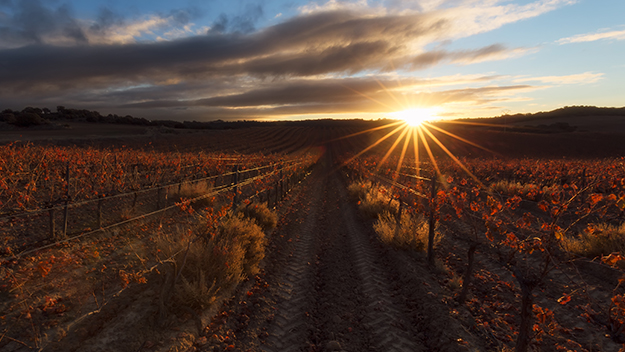Find your winery or vineyard
1 Wineries and Vineyards for sale in Corsica
Infographic of the Denomination of Origin

Change to imperial units (ft2, ac, °F)Change to international units (m2, h, °C)
Corsica
HISTORY
Viticulture began in Corsica in the 6th century BC with the arrival of the Greeks, who started making wine in Aléria on the east coast. However, it was developed mainly by the Romans, who established the capital of the Roman province there and contributed to the development of the vineyard. Then, throughout the Middle Ages, merchants from Pisa and Genoa favoured the wine trade on the northern coast of the island: Patrimonio, Cap Corse and Calvi.
In the 16th century, the cartographer Ignazio Danti, who painted Corsica on the false ceiling of the Vatican gallery, wrote: ‘Corsica has received four great gifts from nature: its horses, its dogs, its fierce and brave men and its most generous wines, which princes hold in the highest esteem’.
In the 18th and 19th centuries, Corsican viticulture developed spectacularly. Between 1788 and 1896, production doubled and the island could easily export to the Parisian region thanks to the arrival of the railway to Sète. At the end of the 19th century, the devastation caused by phylloxera was an economic catastrophe and production collapsed.
At the beginning of the 1960s, with the settlement in Corsica of 17,000 repatriates from Algeria, Corsican viticulture was revived, but in an almost industrial way, with the planting, on more than 14,000 hectares, of high-yielding vines such as Carignan, red Grenache and Samsó. Some families, however, continued to cultivate the traditional varieties. Gradually, Corsican wines took the place of Algerian table wines in a range of low-priced table wines of more than modest quality.
However, this policy went against the new consumption practices while table wine sales collapsed from the 1970s onwards. In twenty years, Corsican viticulture lost two thirds of its vineyards, with the overall surface area falling from 32,000 hectares to only 10,000 hectares at the end of the 1990s, ruining the local economy.
But from the beginning of the 1990s, winegrowers began to react and preach quality. The European Union's wine-growing policy contributed to the replacement of the most productive vines by traditional high quality vines. Today, most of the island's wines have a marked typicality due to the soil conditions and the richness of the local vines. There are about 1,500 ha of vineyards on the island in different appellations.
Most Corsican wines are red, i.e. half of the island's production. There are also rosé wines (light-coloured, fresh and fruity) (25%) and white wines are a minority (10%) and also sweet. It must be said that the use of wood for the ageing of wines hardly exists, as Corsican wines are not suitable for preservation and are intended for early consumption.
The white wine is made with a minimum of 75% Vermentino and a maximum of 25% Ugni Blanc (Tuscan Trebbiano). Red wine and rosé are blended with at least 33% Nielluccio (Sangiovese), 33% Sciacarello (Mammolo) and Grenache Noir, as well as Cinsaut, Mourvèdre (Mourvèdre), Barbarossa, Syrah, Carignan Noir and Vermentino.
The hierarchy of Corsican crus and producers is not yet established, but this does not prevent an elite of wines and wineries from being designated each year, which defines the style of Corsican wines more and more each year.
TYPES OF GRAPES
Corsican wines are not powerful and dense wines like some Languedoc wines. On the contrary, the common characteristic of most of them is freshness. This characteristic favours its white wines from the Vermentino grape, this type of grape, which is called Rolle in Provence, a variety of Malvasia, acquires a freshness and an aromatic finesse far superior to the wines of Languedoc-Rousillon or Provence. As for the red wines, there are two main varieties, Nielluccio and Sciaccarello, each with a different style. The Malvasia, called Malvoisie here, and the Muscat, which is characterised by its freshness with a subtle balance and less sweet than the muscats of the peninsula.
The best is certainly the Sciaccarello, the oldest and best known, which is a red grape that is only grown on the island (in the south), covering 15% of the vineyard. It produces fine and spicy wines, the best crus. Nielluccio, which probably has the same origin as the Italian Sangiovese and occupies around 35% of the island's vineyards, is an ancient red grape.
Other red grape varieties are Aleatico, Garnacha, Cinsault, Carcajolo noir and Careñena (carignan) and white grapes Cordivarta, Barbarossa, Ugni blanc, Carcajolo blanco, Vermentino and Malvasia. There are other autochthonous varieties, but they are in the minority and are not included in wines with designation of origin. And the more international varieties, such as Merlot, Cabernet or Chardonnay, have a token presence.
D.O./Valle (wine regions)
Discover more wineries and vineyards for sale in these wine regions in Islands
Subscribe to our mailing list to receive news about wineries and vineyards.








